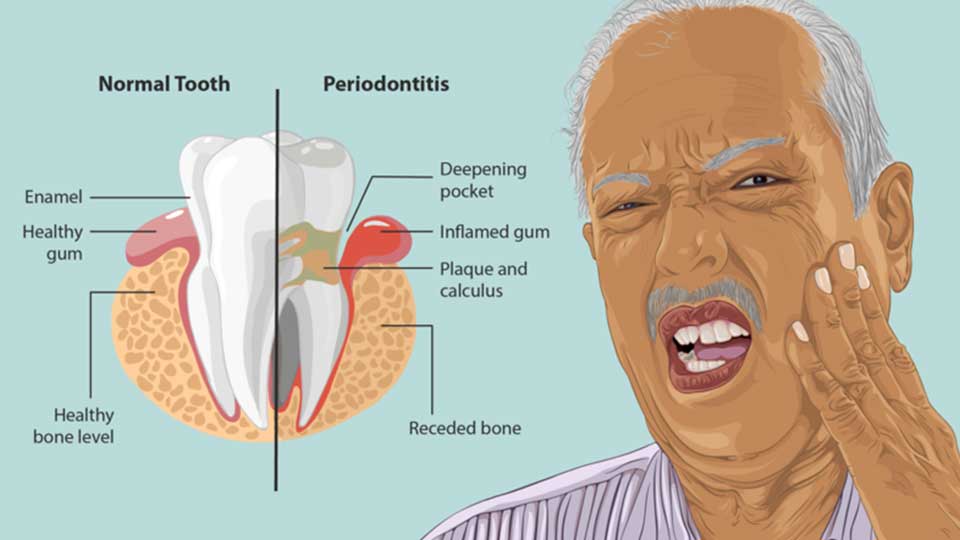Most people think of oral health as only pertaining to your teeth. But your gums are just as important.
Unfortunately, half of all American adults have some form of gum disease. Periodontitis can lead to serious infection and tooth loss if not treated. Early detection and treatment is crucial to saving your teeth from gum disease.
Keep reading to learn the common signs of early periodontitis so you can get the treatment you need.
What Is Early Periodontitis?
Early periodontitis refers to the early stages of gum disease. Periodontitis is a progressive condition that originates from a plaque build-up in the gums. The toxins in plaque can cause irritation and infection in the gum tissue, which leads to periodontitis.
What Causes Periodontitis?
Periodontitis is the result of plaque and toxin build-up in your gums and between your teeth. The toxin and bacteria build-up causes your body to attack and, as a result, damage your gum tissue.
This results in gum inflammation. As your gums swell because of the plaque build-up, the teeth separate slightly from the gum creating a pocket between your teeth and your gums.
This allows even more plaque to accumulate and can even trap food debris as well. All of this leads to periodontal disease and infection, which can cause permanent damage and tooth loss.
The best way to prevent gum disease is to keep up with proper oral hygiene. This means brushing at least twice daily along with flossing daily. You should also be getting regular check-ups at the dentist by going at least once every six months.
Signs of Early Periodontitis
Many of the symptoms of early periodontitis can seem innocuous and unrelated to gum disease. Many people find that they have little to no symptoms at all.
That’s why it’s important to have regular check-ups with a dentist; they will be able to assess your gum health even if you are experiencing no symptoms of gum disease.
Let’s look at some of the most common symptoms of periodontitis that you should be looking out for.
Bad Breath
Consistent bad breath could simply be a result of old food on the back of your tongue or just a garlicky salad from your lunch. However, it can also be caused by particles of food that have become lodged in your gumline.
Gum disease creates pockets in your gums that can easily trap food particles. This leads to a bad odor and chronic halitosis.
Bleeding Gums
Many people believe that it is normal and O.K. if your gums bleed while flossing or brushing. This is actually not the case: bleeding is one of the most common symptoms of early periodontitis.
Gum disease hurts your gum tissue, which makes it vulnerable to bleeding. If you are bleeding when brushing your teeth, flossing, or eating, this could be a sign of gum disease.
Painful and/or Swollen Gums
A sign of early periodontitis is infection, which can lead to swollen and painful gums. If your gums are sensitive, painful, and inflamed, this is a sign that you have gum disease.
This is a serious symptom that can lead to tooth loss and bone damage if not treated quickly. See your dentist for a periodontics exam immediately if your gums are swollen and painful.
Tooth Sensitivity
Sensitive teeth can be a result of periodontitis as well. As periodontitis gets progressively worse, your gumline will begin to recede. This can leave the roots of your teeth exposed, which can make them sensitive to both high and low temperatures.
If you notice your teeth are sensitive when eating or drinking either hot or cold food and drink, definitely make an appointment to see your dentist.
Receding Gumline
As we mentioned earlier, gum disease can cause your gumline to recede. The toxins that have built up in your gums can result in gum tissue being destroyed. This causes a receding gumline and the appearance that your teeth are getting longer.
Pus
Pus is your body’s natural response to fighting an infection. Gum disease can lead to an infection that will result in pus and/or abscesses forming in your mouth.
Pus is usually yellow in color and it both smells and tastes bad. If you notice pus in your mouth and between your teeth, this is a sign of infection and should be immediately checked out by a dentist.
Risk Factors for Periodontitis
Besides the different symptoms you could be experiencing, some people have certain risk factors that make them more prone to developing periodontal disease.
1. Age
Older people are more likely to have a form of periodontal disease. The rates of periodontitis are much higher in older individuals. According to the CDC, 70% of people over the age of 65 having periodontitis.
2. Genetics
There is some research suggesting that genetics could be a factor in gum disease. If other people in your family have gum disease, then you could be at a higher risk.
3. Poor Nutrition
Your nutrition can also increase your risk of gum disease. If you are obese or simply are not getting proper nutrition, your body isn’t able to fight off infection as well as a healthy individual. And since infection is a big part of periodontal disease, this can make your risk of developing gum disease much higher.
4. Smoking
Numerous studies have directly linked tobacco use to a higher risk of developing gum disease. Compared to a non-smoker, a smoker is twice as likely to develop gum disease. Not only that, the treatments for gum disease are less likely to be effective if you smoke.
Conclusion
Gum disease can sneak up on you with either no symptoms or seemingly normal symptoms. But if you notice anything we have detailed here, then you need to see a dentist to make sure that periodontitis isn’t the culprit. And if it is, a dentist will be able to start treatment right away.
If you’d like more information on periodontal disease or if you’re looking to schedule an appointment, contact us.

